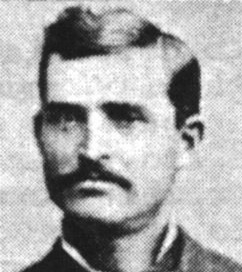Benjamin Julius Johnson
(1857-1937)
Benjamin Julius Johnson was born to Benjamin Franklin Johnson and Sarah Melissa Homan Johnson, May 10, 1857 in Santaquin, Utah. His family moved to Spring Lake, Utah when he was 8 years old.
His father was engaged in agricultural pursuits and was also somewhat of an expert in horticulture, planting quite a large orchard and engaging in making syrup, ketchup, keeping bees, using the whole family to help with the work. So Benjamin Julius was brought up learning various occupations, which knowledge served him well in the task of pioneering.
He married Isabelle Millican Russell, November 28, 1878. Sometime between 1880 and 1883 he with his family wife and twin boys moved to Tempe, Arizona, where he engaged in general farming, specializing in bee culture and honey. A daughter, Isabelle Melissa, was born at Tempe, May 19, 1883. Shirley H. was born April 12, 1886. About this time, he moved out on the “Bench” in Mesa, Arizona and developed a large apiary. While at this place he became interested in a young lady by the name of Harriet Jane Hakes and, with the consent of his wife, Belle, they decided he should marry Jane and all move to Mexico where they could live polygamy legally.
A covered wagon was outfitted for the trip, and with a single team of horses they headed for the newly established colonies. Starting early in the fall, they crossed the line at Palomas and camped at a nearby lake. Here Alexander F. Macdonald caught up with them and that same night performed the ceremony then joined Harriet Jane Hakes in marriage to Benjamin Julius Johnson as wife number two. This was October 22, 1889. The stepson of L. V. Guthrie traveled with them and he, too, was married to Winnie Johnson, the same night by A.F. Macdonald.
They traveled on to Colonia Juarez where they bought a house and a small plot of land. The house stood against the hill at the northeast corner of town, above the crossing of the Eastern canal. The plot of land was situated under and adjacent to the west side of the canal. He later built a four room house and tore down the old Orvel Allen two-room shack. The plot of ground served as a family garden and help supply the family food.
These were really hard times, at least for a season, as most of his resources have been spent on the journey. But Benjie, as he was called, was resourceful and versatile. He had learned plastering, and, as a number of brick and Adobe houses were being constructed, he obtained considerable employment, which brought much needed income.
The Johnson family contributed to the cultural life of the colony. Belle had some literary talent and also gave lessons on the organ. Benjie, with natural music talent, played various instruments. He was especially efficient with the violin, and made an excellent fiddler when square dancing was an informal social exercise. He with his lively fiddle and “Uncle Pete” Wood with his flute, playing for many of the hometown dances.
In May, 1895, Benjie moved to Chuhuichupa, where four or five other families had already settled. Sometime later a Branch was organized under the jurisdiction of the Bishop of Pacheco and Benjie was called to be the Presiding Elder until George M. Haws of Colonia Juarez was called to preside over the Chuhuichupa Ward. Benjie was then set apart as a Counselor to the Bishop. Later he was ordained Bishop.
The Johnson family became a sort of hot for cultural and social activities with Benjie at the center as chorister and dance fiddler, and daughter, Belle, at the organ. Later his son Frank became the choir leader, school principal and a leader in academic activities, which “relieved” Uncle Benjie’s overcrowded agenda of Ward duties. Besides serving as leader in religious activities, Benjie set the pace in home beautification. Although not blessed with great financial resources, he did the best he could with what he had. He planted the first apple and cherry orchards in Chuhuichupa. On his farm he raised oats, corn and potatoes. He also worked at sawmilling between farming seasons. His favorite activity was horticulture, and, inasmuch is Chuhuichupa did not seem to fulfill his expectations in this field, he looked elsewhere for a better opportunity. The search led him to Coahuila, Mexico, where his cousin Derby Johnson was promoting a colonization project. This appealed to him as “the Place.” So he decided to make the move and in the early spring of 1911 he moved to Coahuila. However, because of the Revolution in Mexico, he became apprehensive and didn’t stay long in Coahuila, moving to Blue Water, New Mexico, where Colin Hakes, brother of his second wife, Harriet Jane, presided as Bishop. Here Benjie with his two sons Frank and Shirley, engaged in the business of burning lime. But this was not the occupation for Benjie, so he with his sons moved to Mesa, Arizona, in the winter of 1913.
There he engaged in farming, gardening and dairying, until his health began to fail. Then he became a full-time worker in Mesa Temple until the time of his death on February 10, 1938, ten years to the day after his wife Bell passed away. He was buried beside Bell in the Mesa Cemetery close to the graves of his father and mother.
Isabelle Johnson Sevey, daughter
Stalwarts South of the Border, Nelle Spilsbury Hatch page 341

